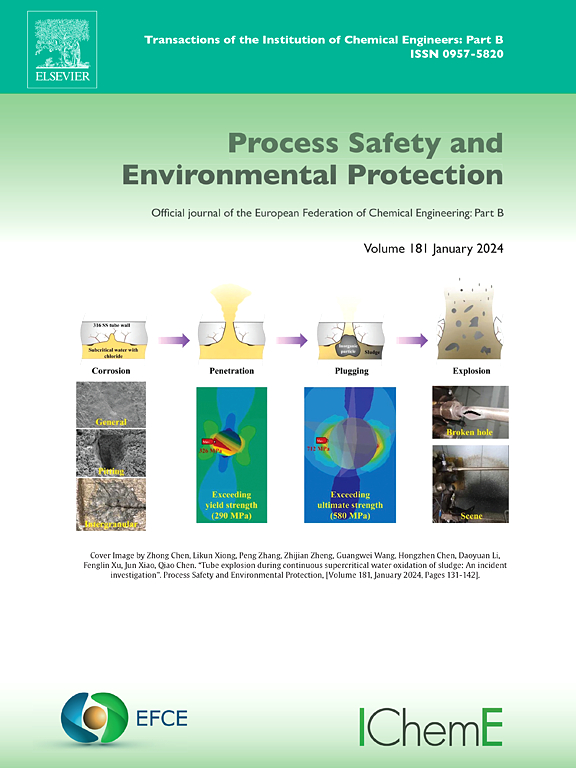高速公路上的氢燃料电池汽车:泄漏扩散特性和安全性评价
IF 6.9
2区 环境科学与生态学
Q1 ENGINEERING, CHEMICAL
引用次数: 0
摘要
随着氢燃料电池汽车(HFCVs)的快速发展,高速公路氢气泄漏和爆炸风险迫切需要深入研究。本研究通过构建三维公路事故模型,将计算流体力学(CFD)与TNO多能法相结合,系统分析了泄漏孔径(2 mm、4 mm、10 mm)、泄漏体积(64 L、128 L、192 L)、环境风速(0-8 m/s)和障碍物布置对氢气扩散和爆炸后果的影响。结果表明,在开放环境下,泄漏孔径和泄漏量越大,环境风速越低,障碍物密度越高,爆炸危险性增加越显著。例如,孔径为10 mm、泄漏体积为192 L、风速为0 m/s时,超压峰值达到68.9 kPa,对应90 %的鼓膜破裂距离为1.65 m。本研究进一步提出了核心危险区≤1.65 m、次级危险区1.65 ~ 6.86 m、外围监控区6.86 ~ 15 m的三级应急疏散策略,可为高速公路氢动力汽车事故应急响应提供科学依据。研究结果填补了开放环境下氢安全评价的空白,对推动氢能运输的大规模应用具有重要意义。本文章由计算机程序翻译,如有差异,请以英文原文为准。
Hydrogen fuel cell vehicles on highways: Leakage diffusion characteristics and safety assessment
With the rapid development of hydrogen fuel cell vehicles (HFCVs), the risk of hydrogen leakage and explosion on highways urgently requires in-depth research. This study systematically analyzed the impact of leak aperture (2 mm, 4 mm, 10 mm), leakage volume (64 L, 128 L, 192 L), environmental wind speed (0–8 m/s), and obstacle layout on hydrogen diffusion and explosion consequences by constructing a three-dimensional highway accident model and integrating computational fluid dynamics (CFD) with the TNO Multi-Energy method. The results indicate that in an open environment, the greater the leak aperture and leakage volume, the lower the environmental wind speed, and the higher the density of obstacles, the more significant the increase in explosion risk. For instance, under conditions of a 10 mm aperture, 192 L leakage volume, and 0 m/s wind speed, the peak overpressure reaches 68.9 kPa, corresponding to a 90 % tympanic membrane rupture distance of 1.65 m. This study further proposes a three-tier emergency evacuation strategy (core danger zone ≤1.65 m, secondary risk zone 1.65–6.86 m, peripheral monitoring zone 6.86–15 m), which can provide a scientific basis for emergency response to hydrogen vehicle accidents on highways. The findings fill the gap in hydrogen safety assessment in open environments and are of great significance for promoting the large-scale application of hydrogen energy transportation.
求助全文
通过发布文献求助,成功后即可免费获取论文全文。
去求助
来源期刊

Process Safety and Environmental Protection
环境科学-工程:化工
CiteScore
11.40
自引率
15.40%
发文量
929
审稿时长
8.0 months
期刊介绍:
The Process Safety and Environmental Protection (PSEP) journal is a leading international publication that focuses on the publication of high-quality, original research papers in the field of engineering, specifically those related to the safety of industrial processes and environmental protection. The journal encourages submissions that present new developments in safety and environmental aspects, particularly those that show how research findings can be applied in process engineering design and practice.
PSEP is particularly interested in research that brings fresh perspectives to established engineering principles, identifies unsolved problems, or suggests directions for future research. The journal also values contributions that push the boundaries of traditional engineering and welcomes multidisciplinary papers.
PSEP's articles are abstracted and indexed by a range of databases and services, which helps to ensure that the journal's research is accessible and recognized in the academic and professional communities. These databases include ANTE, Chemical Abstracts, Chemical Hazards in Industry, Current Contents, Elsevier Engineering Information database, Pascal Francis, Web of Science, Scopus, Engineering Information Database EnCompass LIT (Elsevier), and INSPEC. This wide coverage facilitates the dissemination of the journal's content to a global audience interested in process safety and environmental engineering.
 求助内容:
求助内容: 应助结果提醒方式:
应助结果提醒方式:


